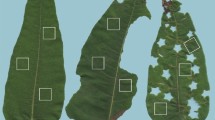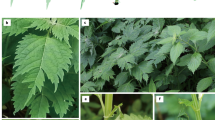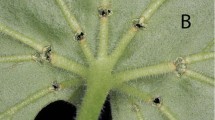Abstract
Insect folivores on plants protected by secretory canals commonly sever leaf veins or cut trenches before feeding beyond the cuts. Previous studies reported that vein cutting occurs when canals have an arborescent arrangement, whereas trenching is found when canals have a net-like arrangement. However, some danaine species, such as the monarch caterpillar, Danaus plexippus, show both behaviors on the same milkweed plant; early instars cut circular trenches and later instars chew furrows in the leaf midrib. This study tests the hypothesis that milkweed canals differ in arrangement at different scales, thus requiring different behaviors from early and late instars. I compared common milkweed, Asclepias syriaca (Apocynaceae) with prickly lettuce, Lactuca serriola (Asteraceae). Leaves were damaged with standard wounds and the response of the laticifers was compared by measuring latex exudate. With L. serriola, severing either the primary or secondary veins failed to reduce latex emission beyond the cuts. The veins and associated laticifers form an interconnected network; plusiine caterpillars on L. serriola disarm the network with a trench. With A. syriaca, transecting the midrib virtually eliminated distal exudation. However, severing a secondary vein caused only a partial reduction. To decrease exudation beyond secondary veins, milkweed insects need either to sever multiple adjacent veins (as shown by Labidomera clivicollis beetles) or to cut a trench (as in early instar danaine larvae). Thus, in both A. syriaca and L. serriola, herbivore behaviors match the laticifer systems as predicted by the hypothesis that canal architecture has a central role in determining behavior.







Similar content being viewed by others
Availability of data
Data are included in the manuscript as Online Resource 1.
References
Agrawal AA (2017) Monarchs and milkweed: a migrating butterfly, a poisonous plant, and their remarkable story of coevolution. Princeton University Press, Princeton
Agrawal AA, Konno K (2009) Latex: a model for understanding mechanisms, ecology, and evolution of plant defense against herbivory. Annu Rev Ecol Evol Syst 40:311–331
Agrawal AA, Petschenka G, Bingham RA, Weber MG, Rasmann S (2012) Toxic cardenolides: chemical ecology and coevolution of specialized plant–herbivore interactions. New Phytol 194:28–45
Araújo ND, Coelho VPM, Ventrella MC, de Fátima AM (2014) Leaf anatomy and histochemistry of three species of Ficus sect. Americanae supported by light and electron microscopy. Microsc Microanal 20:296–304
Bhowmik PC, Bandeen JD (1976) The biology of Canadian weeds. 19. Asclepias syriaca L. Can J Plant Sci 56:579–589
Blaser HW (1945) Anatomy of Cryptostegia grandiflora with special reference to the latex system. Am J Bot 32:135–141
Buttery BR, Boatman SG (1976) Water deficits and flow of latex. In: Kozlowski TT (ed) Water deficits and plant growth, vol IV. Academic Press, New York, pp 233–289
Canaveze Y, Machado SR (2016) The occurrence of intrusive growth associated with articulated laticifers in Tabernaemontana catharinensis A.DC., a new record for Apocynaceae. Int J Sci 177:458–467
Canaveze Y, Mastroberti AA, de Araujo Mariath JE, Machado SR (2019) Cytological differentiation and cell wall involvement in the growth mechanisms of articulated laticifers in Tabernaemontana catharinensis A.DC. (Apocynaceae). Protoplasma 256:131–146
Cass DD (1985) Origin and development of the non-articulated laticifers of Jatropha dioica. Phytomorphology 35:133–140
Castelblanque L, Balaguer B, Martí C, Rodríguez JJ, Orozco M, Vera P (2016) Novel insights into the organization of laticifer cells: a cell comprising a unified whole system. Plant Physiol 172:1032–1044
Chauveaud G (1891) Recherches embryogeniques sur l’appareil laticifere des Euphorbiacees, Urticacees, Apocynees, et Asclepiadees. Annales des Sciences Naturelles: Botanique 14:1–161
Clarke AR, Zalucki MP (2000) Foraging and vein-cutting behaviour of Euploea core corinna (W. S. Macleay) (Lepidoptera: Nymphalidae) caterpillars feeding on latex-bearing leaves. Aust J Entomol 39:283–290
Compton SG (1989) Sabotage of latex defences by caterpillars feeding on fig trees. S Afr J Sci 85:605–606
Condon JM, Fineran BA (1989) Distribution and organization of articulated laticifers in Calystegia silvatica (Convolvulaceae). Bot Gaz 150:289–302
Dehgan B, Craig ME (1978) Types of laticifers and crystals in Jatropha and their taxonomic implications. Am J Bot 65:345–352
Demarco D, Castro MM (2008) Laticíferos articulados anastomosados em espécies de Asclepiadeae (Asclepiadoideae, Apocynaceae) e suas implicações ecológicas. Rev Bras Bot 31:701–713
Demarco D, Kinoshita LS, Castro M (2006) Laticíferos articulados anastomosados – novos registros para Apocynaceae. Rev Bras Bot 29:133–144
Demarco D, Castro MM, Ascensão L (2013) Two laticifer systems in Sapium haematospermum—new records for Euphorbiaceae. Botany 91:545–554
DeVries PJ (1987) The butterflies of Costa Rica and their natural history. Princeton University Press, Princeton
DeVries PJ (1991) Foam barriers, a new defense against ants for milkweed butterfly caterpillars (Nymphalidae: Danainae). J Res Lepid 30:261–266
Dghim F, Bouaziz M, Mezghani I, Boukhris M, Neffati M (2015) Laticifers identification and natural rubber characterization from the latex of Periploca angustifolia Labill. (Apocynaceae). Flora 217:1–9
Dussourd DE (1990) The vein drain; or, how insects outsmart plants. Nat Hist 90:44–49
Dussourd DE (1993) Foraging with finesse: caterpillar adaptations for circumventing plant defenses. In: Stamp NE, Casey TM (eds) Caterpillars: ecological and evolutionary constraints on foraging. Chapman and Hall, New York, pp 92–131
Dussourd DE (1997) Plant exudates trigger leaf-trenching by cabbage loopers, Trichoplusia ni. Oecologia 112:362–369
Dussourd DE (1999) Behavioral sabotage of plant defense: do vein cuts and trenches reduce insect exposure to exudate? J Insect Behav 12:501–515
Dussourd DE (2003) Chemical stimulants of leaf-trenching by cabbage loopers: natural products, neurotransmitters, insecticides, and drugs. J Chem Ecol 29:2023–2047
Dussourd DE (2009) Do canal-cutting behaviors facilitate host-range expansion by insect herbivores? Biol J Linn Soc 96:715–731
Dussourd DE (2017) Behavioral sabotage of plant defenses by insect folivores. Annu Rev Entomol 62:15–34
Dussourd DE, Denno RF (1991) Deactivation of plant defense: correspondence between insect behavior and secretory canal architecture. Ecology 72:1383–1396
Dussourd DE, Eisner T (1987) Vein-cutting behavior: insect counterploy to the latex defense of plants. Science 237:898–901
Esau K (1965) Plant anatomy. Wiley, New York
Evert RF (2006) Esau’s plant anatomy. Wiley, Hoboken
Fahn A (1979) Secretory tissues in plants. Academic Press, New York
Ferreira PPS, Rodrigues D (2015) Sabotaging behavior and decision-making in larvae of the Queen butterfly Danaus gilippus. J Insect Behav 28:460–472
Foisy MR, Albert LP, Hughes DWW, Weber MG (2019) Do latex and resin canals spur plant diversification? Re-examining a classic example of escape and radiate coevolution. J Ecol 107:1606–1619
Fordyce JA, Malcolm SB (2000) Specialist weevil, Rhyssomatus lineaticollis, does not spatially avoid cardenolide defenses of common milkweed by ovipositing into pith tissue. J Chem Ecol 26:2857–2874
Gama TSS, Rubiano VS, Demarco D (2017) Laticifer development and its growth mode in Allamanda blanchetii A. DC. (Apocynaceae). J Torrey Bot Soc 144:303–312
Gutiérrez DG, Luna ML (2013) A comparative study of latex-producing tissues in genera of Liabeae (Asteraceae). Flora 208:33–44
Hagel JM, Yeung EC, Facchini PJ (2008) Got milk? The secret life of laticifers. Trends Plant Sci 13:631–639
Helmus MR, Dussourd DE (2005) Glues or poisons: which triggers vein cutting by monarch caterpillars? Chemoecology 15:45–49
Hirai N, Ishii M (2002) Egg placement of the tachinid fly Sturmia bella on leaves of the evergreen milkvine Marsdenia tomentosa and the feeding habit of its host butterfly Parantica sita. Entomol Sci 5:153–159
Hurley KW, Dussourd DE (2015) Toxic geranium trichomes trigger vein cutting by soybean loopers, Chrysodeixis includens (Lepidoptera: Noctuidae). Arthropod-Plant Interact 9:33–43
Kajii C, Morita T, Kuroda K (2014) Laticifers of Ficus carica and their potential role in plant defense. IAWA J 35:109–115
Kalaisekar A, Sarma S (2019) Feeding behaviour of chrysomelid leaf beetles Aplosonyx chalybaeus (Hope) and A. scutellatus (Baly). Indian J Entomol 81:511–515
Kennedy PB, Crafts AS (1931) The anatomy of Convolvulus arvensis, wild morning-glory or field bindweed. Hilgardia 5:591–622
Konno K (2011) Plant latex and other exudates as plant defense systems: roles of various defense chemicals and proteins contained therein. Phytochemistry 72:1510–1530
Lees DC, Zilli A (2019) Moths: their biology, diversity and evolution. Natural History Museum, London
Lewinsohn TM, Vasconcellos-Neto J (2000) Como insetos sabotam defesas de plantas: o caso do látex. In: Martins RP, Lewinsohn TM, Barbeitos MS (eds) Ecologia e comportamento de insetos. Série Oecologia Brasiliensis, vol VIII. PPGE-UFRJ, Rio de Janeiro, pp 281–298
Mahlberg PG (1961) Embryogeny and histogenesis in Nerium oleander II. Origin and development of the non-articulated laticifer. Am J Bot 48:90–99
Mahlberg PG (1993) Laticifers: an historical perspective. Bot Rev 59:1–23
Metcalfe CR, Chalk L (1983) Anatomy of the dicotyledons, vol II. Clarendon Press, Oxford
Naidoo C, Naidoo Y, Dewir YH (2020) The secretory apparatus of Tabernaemontana ventricosa Hochst. ex A. DC. (Apocynaceae): laticifer identification, characterization and distribution. Plants 9:686
Olson KC, Tibbitts TW, Struckmeyer BE (1969) Leaf histogenesis in Lactuca sativa with emphasis upon laticifer ontogeny. Am J Bot 56:1212–1216
Oppel CB, Dussourd DE, Garimella U (2009) Visualizing a plant defense and insect counterploy: alkaloid distribution in Lobelia leaves trenched by a plusiine caterpillar. J Chem Ecol 35:625–634
Pickard WF (2008) Laticifers and secretory ducts: two other tube systems in plants. New Phytol 177:877–888
Prado E, Demarco D (2018) Laticifers and secretory ducts: similarities and differences. In: Hufnagel L (ed) Ecosystem services and global ecology. IntechOpen, London, pp 103–123
Rodrigues D, Maia PHS, Trigo JR (2010) Sabotaging behaviour and minimal latex of Asclepias curassavica incur no cost for larvae of the southern monarch butterfly Danaus erippus. Ecol Entomol 35:504–513
Teixeira SP, Marinho CR, Leme FM (2020) Structural diversity and distribution of laticifers. Adv Bot Res 93:27–54
Van Veenendaal WLH, Den Outer RW (1990) Distribution and development of the non-articulated branched laticifers of Morus nigra L. (Moraceae). Acta Bot Neerlandica 39:285–296
Vertrees GL, Mahlberg PG (1978) Structure and ontogeny of laticifers in Cichorium intybus (Compositae). Am J Bot 65:764–771
Wason EL, Hunter MD (2014) Genetic variation in plant volatile emission does not result in differential attraction of natural enemies in the field. Oecologia 174:479–491
Wilson KJ (1986) Immunological-cytochemical localization of cell products in plant tissue culture. In: Linskens HF, Jackson JF (eds) Immunology in plant sciences. Springer, New York, pp 212–230
Zalucki MP, Brower LP (1992) Survival of first instar larvae of Danaus plexippus (Lepidoptera: Danainae) in relation to cardiac glycoside and latex content of Asclepias humistrata (Asclepiadaceae). Chemoecology 3:81–93
Acknowledgements
Many thanks to Erin Wiley, Karen M. Kester, and two anonymous reviewers for very helpful comments on the manuscript and to the University of Central Arkansas Research Council for financial support.
Funding
The research was supported by funding from the University of Central Arkansas Research Council.
Author information
Authors and Affiliations
Corresponding author
Ethics declarations
Conflicts of interest
The author declares that he has no conflict of interest.
Additional information
Handling Editor: Heikki Hokkanen.
Publisher's Note
Springer Nature remains neutral with regard to jurisdictional claims in published maps and institutional affiliations.
Supplementary Information
Below is the link to the electronic supplementary material.
Rights and permissions
About this article
Cite this article
Dussourd, D.E. Does secretory canal architecture determine the sabotage behaviors of insect folivores?. Arthropod-Plant Interactions 15, 71–81 (2021). https://doi.org/10.1007/s11829-020-09798-x
Received:
Accepted:
Published:
Issue Date:
DOI: https://doi.org/10.1007/s11829-020-09798-x




